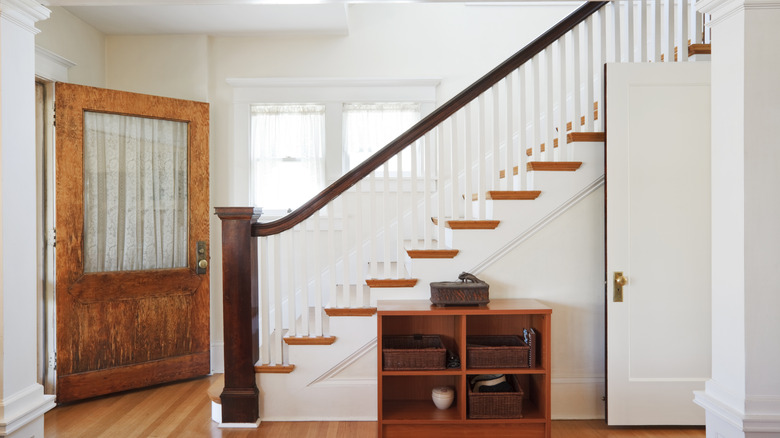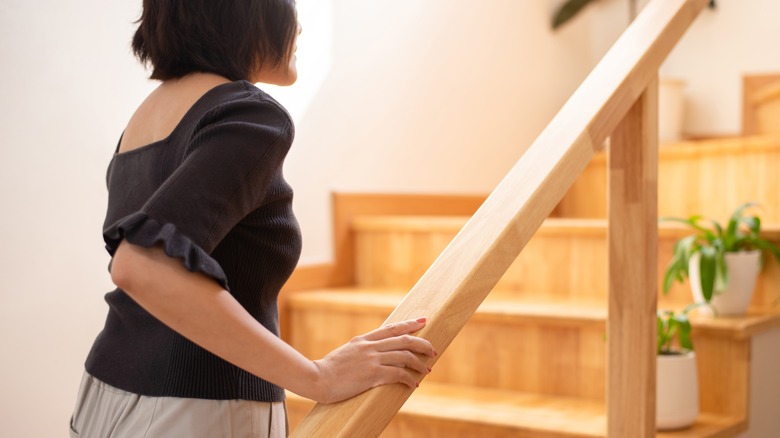Here's How Much A Stair Railing Installation Costs (& Money-Saving Tips To Consider)
If you have a staircase in your home, you should invest in a railing if there isn't one already. Railings are important for safety in the house, as they'll help the homeowners — and visitors — travel up and down the stairs without slipping. Not only are they helpful for keeping your home safe, but railings can also help your staircase appear more attractive, giving the area of your home a more elevated, complete look. With that said, getting the railing installed isn't typically a cheap investment — the price can be anywhere from about $950 to $3,200. But if you want to save money, consider doing the job yourself — if you have the right skills — or opting for relatively affordable materials instead of anything too fancy.
Investing in a railing is one of the best ways to update your staircase, so you'd be doing your home a disservice by not giving your stairs a railing. The railing can potentially even earn you money in the long run, as the desirable feature can improve a house's future resale value. So, be sure to take the investment seriously, as good-quality railings will be most appealing and helpful. But if you're experienced in DIY projects, you may want to create and install your own railing.
Save money by installing the railings yourself
Do you want to avoid spending hundreds or thousands of dollars on getting a new stair railing installed, and do you have experience with DIY home upgrades? There are different ways to do the job at home, saving DIY enthusiasts money. But of course, remember to only use these techniques if you're comfortable handling and working with tools and wood.
If your staircase is attached to a wall, installing a wall-mounted railing will typically be the best approach. First, you'll need to use a tape measure and pencil to mark where to attach the brackets to the wall. Next, use a string and thumbtacks to map out exactly where to do the installing. Then, put your stud finder and drill to work and attach your brackets. Finally, you'll be able to secure your wood railing on the brackets, and it will be ready to use.
While your stairs being attached to a wall will be helpful for DIY railing installations, wall-mounted handrails aren't the only options. If your staircase isn't against a wall, add a wood base against the bottom and top ends. Then, securely connect them with a wood railing for people to hold onto. While you can stop there for a rustic, simple vibe, feel free to paint it and add slimmer poles under the main railing for a chic look. Still, doing the job yourself isn't the only way to avoid breaking the bank.
Opt for a reasonably-priced wood or wrought iron railing
Anyone who isn't comfortable installing stair railings themselves can still save money by choosing affordable materials over anything too expensive. While it might be tempting to invest in exciting aluminum or beautiful glass stair railings, getting a railing made of those stunning materials will cost you thousands of dollars — you'd likely have to pay no less than $3,500 and up to $6,000 for aluminum and as much as $8,500 for glass. Meanwhile, installing a wood railing will usually cost under $1,300, and wrought iron is still more budget-friendly than the more luxurious options, typically costing between $800 and $5,000.
Many homeowners can't go wrong with investing in a traditional wood stair railing, and not just because of the reasonable prices. Wood is reliable and long-lasting, so you can trust the railing to successfully do its job and keep everyone safe on the stairs. Another reason wood is a good material for safety-focused homeowners is that it shouldn't get too hot or cold when anyone holds onto it.
Wrought iron railings are also super reliable and long-lasting. Plus, wrought iron can look very elegant and stylish, serving as a fancier material than wood but typically still less expensive than more deluxe materials. So, rather than depriving your stairs of railings, save money by using affordable processes and materials.

